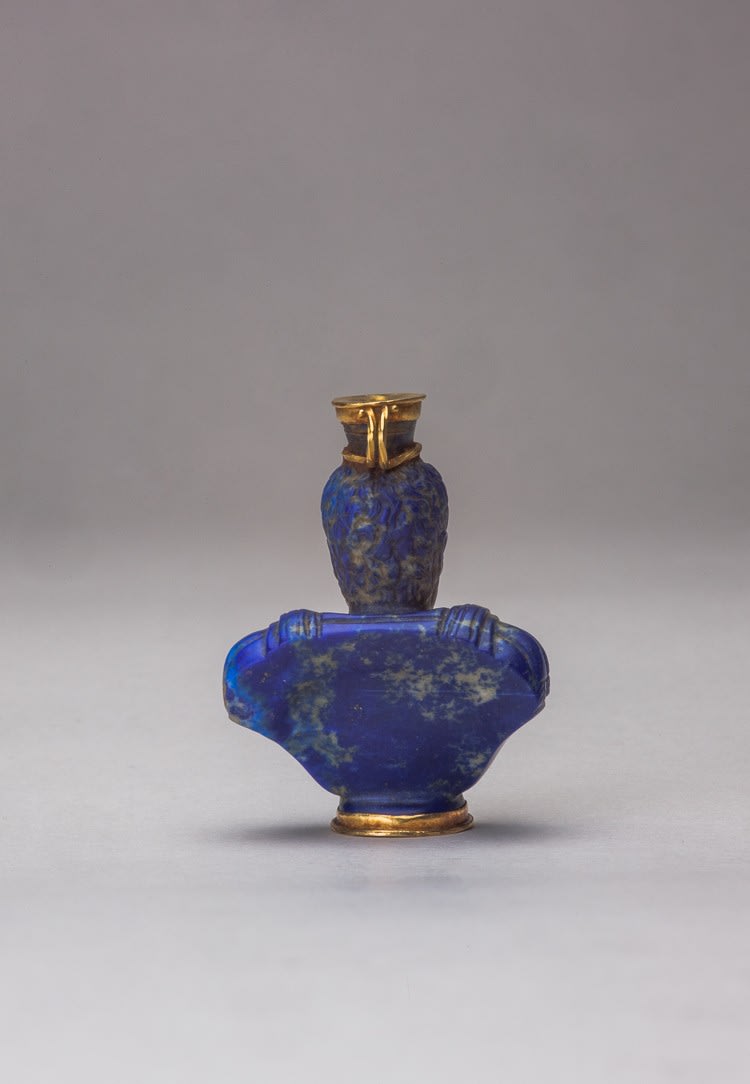Lapis Lazuli unguentarium, 3rd Century CE
Lapis lazuli/ gold
height 4.7 cm
height 1 7/8 in
height 1 7/8 in
HES.0135
Further images
A lapis lazuli unguentarium in the form of a bust in all possibility representing the Emperor Hadrian. Hadrian is portrayed in full regalia according to his first official portrait representation...
A lapis lazuli unguentarium in the form of a bust in all possibility representing the Emperor Hadrian.
Hadrian is portrayed in full regalia according to his first official portrait representation as Emperor, created just after seizing power in 117 A.D.
The bust, regardless of it's minute dimensions, captures with accuracy all the typical facial traits of Hadrian: a short and perfectly trimmed beard, as was in fashion among the Greek philosophers and intellectuals of the time, and a very defined hair style, with delicate curly waves, which give the portrait a particularly realistic effect.
Hadrian was the first Roman Emperor to adopt the use of the long beard, a distinctive symbol of his admiration for the Greek culture and philosophy. He is wearing a cuirass with two braces strapped on the front and adorned with the Gorgon’s head on the centre. The bust is framed by a simple round gold band on both the upper part and the base, as a further indication of its intrinsic value.
Lapis Lazuli was much prized during antiquity for its intense colour and rarity.
Born in 76 A.D into a Hispano-Roman family related to the Emperor Trajan, he was officially adopted by him in 117 A.D., when Trajan was proclaimed himself Emperor under the name of Imperator Caesar Traianus Hadrianus Augustus.
Hadrian is reputed for his numerous and lengthy journeys in the Roman Provinces, for his extensive architectural projects and for his devotion to his lover Antinous; he died in 138 A.D after formally adopting his successor Antoninus Pius. This splendid unguentarium (small container for scented oil) it is a superb example of the craftsmanship of Roman artists and of their excellence for realism in portraits.
Bibl: J. J. Bernoulli, Röm. Ikon., II, 2, p. 105 ss.; R. West, Römische Porträt-Plastik, Monaco 1933, II, p. 111 ss.; B. M. Felletti Maj, Un nuovo ritratto di Adriano, in Arti Figurative, II, 1946, p. 22 ss.; J. Fink, Beiträge zum Bildnis Kaiser Hadrians, in Arch. Anz., 1955, c. 69 ss.; M. Wegner, Das römische Herrscherbild-Hadrian, Berlino 1956 (catalogo e precedente bibl. a p. 92 ss.). Monete: H. Mattingly, Coins of the Roman Empire in the Brit. Museum, III, Londra 1936, p. 236 ss.; P. L. Strack, Römische Reichsprägung des zweiten Jahrhunderts, I, Stoccarda 1931, p. 230 ss.; II, Hadrian, Stoccarda 1933; A. Levi Calò, Adrian as King of Egypt, in Numismatic Chronicle, VIII, 1948, p. 30 ss.
(B. M. Felletti Maj)
Hadrian is portrayed in full regalia according to his first official portrait representation as Emperor, created just after seizing power in 117 A.D.
The bust, regardless of it's minute dimensions, captures with accuracy all the typical facial traits of Hadrian: a short and perfectly trimmed beard, as was in fashion among the Greek philosophers and intellectuals of the time, and a very defined hair style, with delicate curly waves, which give the portrait a particularly realistic effect.
Hadrian was the first Roman Emperor to adopt the use of the long beard, a distinctive symbol of his admiration for the Greek culture and philosophy. He is wearing a cuirass with two braces strapped on the front and adorned with the Gorgon’s head on the centre. The bust is framed by a simple round gold band on both the upper part and the base, as a further indication of its intrinsic value.
Lapis Lazuli was much prized during antiquity for its intense colour and rarity.
Born in 76 A.D into a Hispano-Roman family related to the Emperor Trajan, he was officially adopted by him in 117 A.D., when Trajan was proclaimed himself Emperor under the name of Imperator Caesar Traianus Hadrianus Augustus.
Hadrian is reputed for his numerous and lengthy journeys in the Roman Provinces, for his extensive architectural projects and for his devotion to his lover Antinous; he died in 138 A.D after formally adopting his successor Antoninus Pius. This splendid unguentarium (small container for scented oil) it is a superb example of the craftsmanship of Roman artists and of their excellence for realism in portraits.
Bibl: J. J. Bernoulli, Röm. Ikon., II, 2, p. 105 ss.; R. West, Römische Porträt-Plastik, Monaco 1933, II, p. 111 ss.; B. M. Felletti Maj, Un nuovo ritratto di Adriano, in Arti Figurative, II, 1946, p. 22 ss.; J. Fink, Beiträge zum Bildnis Kaiser Hadrians, in Arch. Anz., 1955, c. 69 ss.; M. Wegner, Das römische Herrscherbild-Hadrian, Berlino 1956 (catalogo e precedente bibl. a p. 92 ss.). Monete: H. Mattingly, Coins of the Roman Empire in the Brit. Museum, III, Londra 1936, p. 236 ss.; P. L. Strack, Römische Reichsprägung des zweiten Jahrhunderts, I, Stoccarda 1931, p. 230 ss.; II, Hadrian, Stoccarda 1933; A. Levi Calò, Adrian as King of Egypt, in Numismatic Chronicle, VIII, 1948, p. 30 ss.
(B. M. Felletti Maj)







